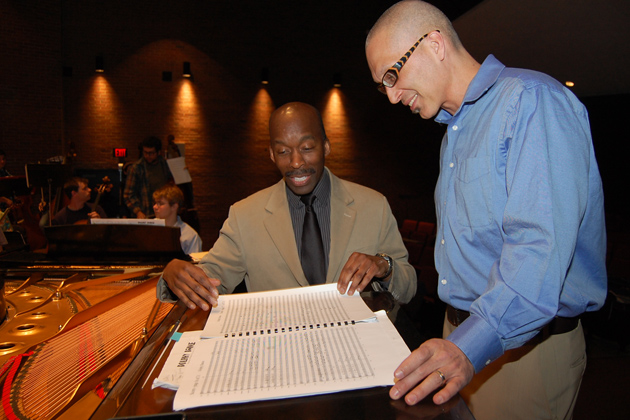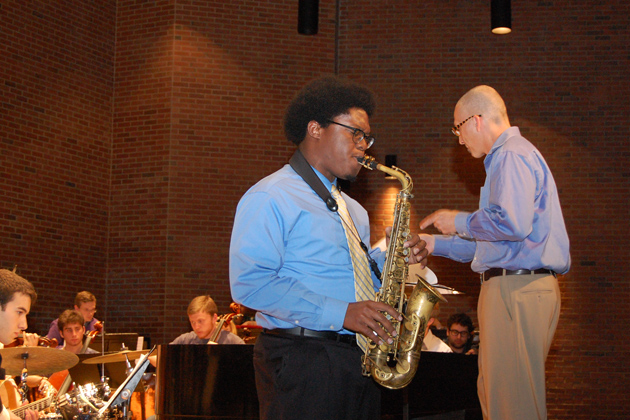
When Earl MacDonald was studying with Charlie Banacos, the legendary teacher of improvisation at Berklee College of Music and New England Conservatory of Music, Banacos suggested that he should focus on the multi-instrumentalist Eric Dolphy as part of their work together.
MacDonald, director of jazz studies in the School of Fine Arts, says he was reluctant at first, thinking the dissonances in Dolphy’s post-bebop style were unsettling. Banacos said, “That’s what you should be studying.”
“It was very eye-opening,” says MacDonald, who will debut his composition for symphony orchestra, “Dolphy Dance,” at the von der Mehden Recital Hall May 1. “I developed an appreciation for his style. I continue to study those concepts.”
“Dolphy Dance” is part of the final Department of Music program for the academic year that includes works by Johannes Brahms, Edward Elgar, and Symphony No. 5 in D, Op. 47 by Dimitri Shostakovich. The composition represents the first time that MacDonald, an award-winning jazz composer and performer, has written for an orchestra, and he will conduct the performance by the UConn Symphony Orchestra, augmented with a rhythm section and jazz soloists.
The composition is highlighted by a section featuring a salsa rhythm that grew out of a song MacDonald wrote for a friend’s surprise birthday present last year. In preparating the birthday tribute, he listened to recordings by the legendary Latin jazz innovators Mario Bauza, Eddie Palmieri, and Tito Puente.

Further exploring salsa rhythms came to mind after MacDonald was asked by Harvey Felder, director of orchestra studies, to consider composing a new work for a collaborative performance for students in the jazz studies and orchestral programs in the Department of Music.
“I had always wanted to write for strings,” MacDonald says. “As I experimented with taking salsa melodies and harmonies further left of center, I began imagining what Eric Dolphy might have sounded like had he been featured with a salsa band around 1960.”
Felder, whose father was a jazz fan with a collection of recordings “that was the envy of many,” says he has been long fascinated with the genre.
“I’ve listened to a lot of jazz in my life and always appreciated jazz artists and what they bring to our culture,” he says. “I thought it would be a great experience for our orchestral musicians to have some jazz experience. I think it’s a very healthy thing to venture into all types of genres.”
Both faculty musicians say one of the challenges for the collaboration between jazz and classical players is matching up the rhythmic accuracy and precision of two varied styles. Orchestras do not typically have a rhythm section of bass and drums driving the music.
“An 80-person orchestra doesn’t swing the way a trio swings or the way a big band swings,” says Felder, who has collaborated with trumpeter Doc Severinsen, singer Al Jarreau, and saxophonist Kenny G, among other jazz musicians over the years. “The larger an ensemble gets, the more unwieldy it is. It’s an ocean liner, not a jet ski.”
MacDonald says the fact that the musicians performing his composition are also students who listen to a wide range of contemporary music – such as pop, rock, and hip-hop – that is based in rhythm, has helped to bring together the jazz and classical musicians.

In composing “Dolphy Dance,” MacDonald says he was also faced with trying to balance writing for classical musicians who are trained to play what is on the written page, with some room for interpretation, and for jazz musicians who expect to have the freedom to improvise at some point. While the entire work is notated on the page, the composer has allowed for some solo improvisation by Colin Walters ’14 (SFA), an alto saxophonist who, MacDonald says in the performances’ program notes, “will play the role of Eric Dolphy.”
“I’ve allowed a little bit of space where he will be improvising,” says MacDonald, who spent two years as musical director and arranger for trumpeter Maynard Ferguson. “But around that I’ve dictated what the strings, brass, and woodwinds will be playing in the background. That’s not much different than from a jazz big band context.”
Listen to MacDonald rehearsing his new composition ‘Dolphy Dance’ with the UConn Jazz Ensemble and Symphony Orchestra.
Felder will conduct the Shostakovich work, the epic composition written in response to Joseph Stalin’s limitations on artistic freedom in the Soviet Union in the 1930s. He says the requirement for a full orchestra of musicians, the historic context of the work, and the “exquisite” nature of the music all make it a special performance opportunity for students.
“This is a great teaching piece,” Felder says. “It allows you connect to history, politics, and social phenomena in an academic environment. This piece allows you to address all those things in the music. It’s a fun piece to play. It moves quickly, and there are moments where time seems suspended. It covers every end of the emotional spectrum. It’s great stuff.”
The program also will include “Academic Festival Overture, Op. 80” by Brahms, and “Serenade, Op. 20 in E Minor, for String Orchestra by Elgar, conducted by Paul McShee, a graduate student in orchestral studies.
The performance will take place on Thursday, May 1, at 8 p.m. at von der Mehden Recital Hall. For more information go to the Department of Music website.



